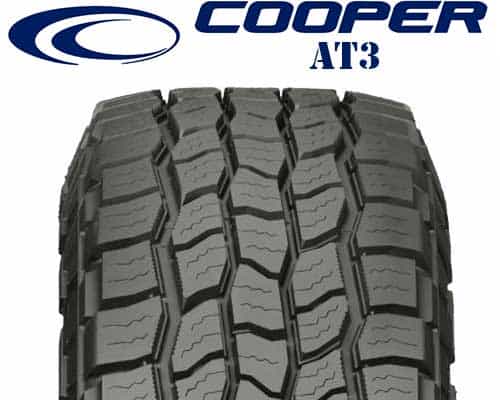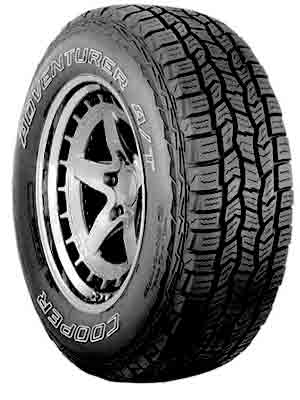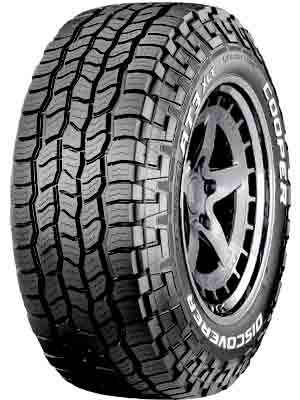Both of these are All-Terrain tires. And both are very similar when it comes to their tread pattern. But if you look close enough, you’ll notice that the Adventurer gives a slightly more aggressive look than the Discoverer. Because of this, Cooper Adventurer AT suits more for off-road trips as its open tread is designed to deal efficiently with mud and snow.
But don’t confuse yourself with the Cooper Adventurer HT, its a different variant. (Check the difference between both tires).

Side Note: With more contact with the road Cooper Discoverer AT3 is a better fit if you are planing to stay on highways most of the time. (Variants of Cooper Discoverer)
Let’s see why its that so.
Table of Contents
Comparing Adventurer AT vs Discoverer XLT

Vs

Cooper Discover AT3 exhibits a rugged look due to its deep tread channels and elevated lugs. Bulky and raised blocks form three central ribs among deep longitudinal grooves.
Due to the irregular shape of blocks, horizontal grooves are asymmetrically-shaped while the circumferential grooves have a curvy design.
Various blocks of central part and shoulders have a zigzag saw-toothed edge.
Step edging of blocks has formed strong ledges at their base which creates a repelling effect on bombarding gravel particles.
All blocks are marked by Zigzag slit-like sipes.
Its shoulders are bulky and firm, having alternatively scooped edges on their outer side while inner edges are connected with each other through tiny tie bars.
It has an aggressive sidewall design as well, the prominent and raised sidewall lugs enhance its bold look.
Cooper Adventurer A/T

Cooper AT3 XLT

Adventurer AT bears much similarity in design with the competitor as it also has four grooves and block rows running circumferentially in the central part.
If we talk about differences, its blocks have more spaces in between.
Lateral grooves are also comparatively wider just like the longitudinal ones.
Blocks are arranged in such orientation that none of its groove is linear, instead two central ones are wave-shaped while marginal and lateral grooves have crisp, irregular patterns.
Sturdy shoulders have alternate scooping on the outer edge, zigzag siping on the upper side, and blocks of varying lengths.
Central blocks also possess straight and zigzag sipes over them. This tire lacks stone ejectors or step edges to repel stones and tie bars to connect shoulder blocks.
Furthermore, its sidewalls are less aggressive and textured in comparison.
On-Road Traction Comparison
Discoverer offers a supreme experience when driving on paved tracks owing to its bulky tread.
High contact patch allows the tread to grip over the road firmly and presents good traction.
Large shoulder blocks bite over the road firmly and sturdy sidewalls give lateral stability while taking turns, thus, it shows a controlled steer response.
When it rolls over the wet pavement, zigzag sipes and deep voids act as water wipers and remove the water layer from road to minimize slipping off and account for a strong grip on the wet road.
Lateral grooves, sipes, and shoulder scoops all act together to ensure smooth steering on a wet track.
Adventurer provides reliable traction on road like a standard all-terrain tire but it scores lesser in the competition as its tread has relatively less contact patch.
Decreased surface area in contact with the pavement minimizes the grip of tread and makes the ride a little bit wobbly.
On a wet road, hydroplaning is efficiently resisted as wide, deep grooves and sipes wipe the water away from tread yet a lesser contact patch makes it stand behind in the competition.
Which tire is good on Mud?
Discoverer shows a satisfactory performance in mud terrain as its deep voids can evacuate mud and allow the tread to grip over the boggy surface.
However, it loses to its competitor and is not much suitable for areas with loads of mud because its relatively narrow grooves do not have the capacity to deal with heavy mud.
(Cooper launched another tire for this purpose, the Cooper Discoverer RTX)
Adventurer is a good choice if you plan to adventure through marshy terrain because its deep and broad grooves allow efficient removal of mud through them and do not let the debris stuck in the tread, to make the tire lose grip.
Wide lateral channels efficiently evacuate mud and strengthen shoulders grip strongly while cornering.
Which tire is good on snow?
Cooper AT3 can roll through soft snow with confidence but it ranks below in the competition due to the reduced evacuation capacity of its comparatively narrow grooves.
On the ice, it moves without any trouble as bulky blocks of tread have enough surface area to grip over the surface strongly and deep voids along with linear and zigzag sipes wipe off water.
The widened tread provides an advantage to Adventurer when roaming about the snow-covered areas as a massive vacuum is offered by its voids to throw back light snow, clearing both the tread and the path.
On the icy ground, relatively less contact patch offers some trouble in griping over the surface but open voids and sipes play their role efficiently in wiping the water away and helping in maintaining grip.
Which tire is better on Rocky Terrains?
Discoverer provides superior performance in rock terrain owing to its aggressive and strengthened tread.
The rugged pattern helps it to grip over uneven hard surfaces and stone ejectors bounce back hovering stones and pebbles and keep them away from harming the tread by drilling punctures or clogging the grooves.
Sturdy shoulders take the load over tricky turns and maintain lateral stability.
Raised sidewall lugs also assist in stone repelling.
Adventurer has lesser capacity to deal with gravel as it lacks stone ejectors and has less prominent sidewalls.
Aggressive tread has good biting ability over the uneven surface of rocky trails and makes it a reliable option for trail hiking but texture-less sidewalls and absence of ejectors or stone ledges make it prone to punctures and stone clogging.
Side Note: If you need a more efficient off-roader, consider Falken Wildpeak AT3w as well.
Compare Falken Wildpeak AT3w with Cooper Adventurer.
Compare Falken Wilpeak with Cooper Discoverer AT3.
Are both of these tires comfortable?
Discoverer offers more comfort on road in terms of noise production and ease of driving. Its less wide grooves permit little space for the movement of air particles and small tie bars among shoulder lugs make whisper grooves and block the circulation of sound waves, resulting in low sound while rolling.
Comfortable driving is credited to high contact patch which results in good traction.
Adventurer makes more noise while traveling on the road as its broad and deep grooves offer huge space for circulation and resonation of wind particles, producing loud sounds.
It offers a less comfortable driving experience in comparison as relatively lesser traction is provided by its open design on the road.
Are these tires durable?
Durable-tread technology employing shred-resistance silica complex makes Discoverer better in terms of durability.
Its internal construction employs 2 ply casing of polyester compound reinforced by twin high strength belts of steel with nylon casting.
Moreover, its longevity is improved by its design, Even Wear Arc technology of Cooper promotes even and slower wear, while chip and scratch resistance is further enhanced by stone ejecting design.
It is backed by the manufacturer with a mileage warranty of 60,000 miles for tread life.
Adventurer is built from an enhanced rubber which is reinforced by steel belts and silica-based casing, hence, it can withstand chips and abrasions, staying functional for a good duration.
However, its composition is less robust than the competitor and its sidewalls are more susceptible to scratches and cuts due to their less aggressive design, making it less durable in comparison. Cooper tires do not give a treadwear warranty.


